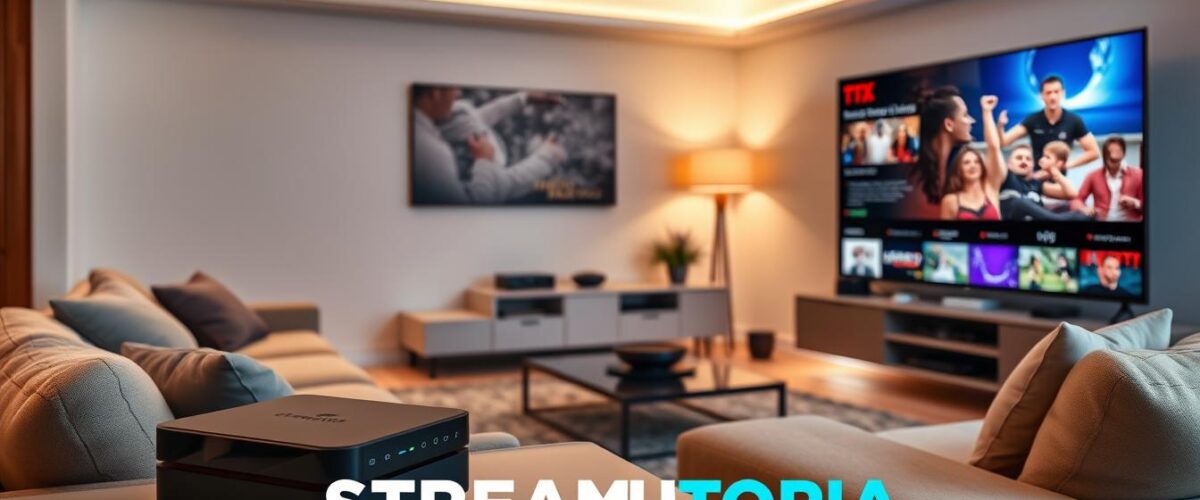Have you ever wondered why so many people switch to IPTV for entertainment? Internet Protocol Television (IPTV) is now the top choice for streaming. It offers many channels, on-demand shows, and great flexibility. For the best IPTV experience, a high-quality setup is key.
In this section, we’ll explore how to set up IPTV streamers for top-notch streaming. We’ll look at the different IPTV streaming devices out there. Knowing these basics helps you pick the best for your viewing needs and enjoy a great experience.
Key Takeaways
- IPTV gives access to a wide range of content, meeting different viewer tastes.
- A solid IPTV setup boosts your streaming experience and cuts down on issues.
- Picking the right IPTV streaming devices is vital for the best performance.
- For quality streaming, you need good internet speed and bandwidth.
- Services like StreamUtopia.com offer flexible plans to fit various needs.
Understanding IPTV and Its Advantages
IPTV, or Internet Protocol Television, is a new way to watch TV. It uses the internet to send TV shows directly to viewers. This method has many benefits, making IPTV a favorite for watching TV.
One big plus of IPTV is its lower cost. Services like Verizon, Netflix, and Hulu offer different packages. This lets users pick only the channels they like, making TV watching more flexible.
Another great thing about IPTV is the wide range of channels and on-demand content. Viewers can watch live TV and choose from many Video on Demand (VOD) options. This flexibility is great for sports fans and families who like to watch their favorite shows whenever they want.
IPTV works on many devices, like smart TVs, computers, and phones. With a Set-Top Box (STB), watching TV online is easy. IPTV’s design also means better streaming quality and easier access to content.
In short, IPTV is changing how we watch TV. Its popularity is growing fast, with a 15.1% CAGR from 2023 to 2032. Many people are choosing IPTV over traditional TV services for its quality and variety.
How IPTV Works: The Basics
IPTV starts with a simple idea. It turns regular media into Internet Protocol (IP) packets. This lets you stream content online without needing cable or satellite.
IPTV offers many services to fit what viewers like. Some main types are:
- Live TV: It shows events as they happen, like sports and news. Services like CBS Sports HQ, Hulu + Live TV, and Sling TV offer this.
- Video on Demand (VOD): You can pick from a big library of movies and shows. Tubi and Pluto TV are great for this.
- Catch Up TV: It lets you watch shows you missed later. This makes watching TV more flexible.
Behind IPTV is a team of experts using special protocols. They make sure streaming is smooth. Protocols like RTSP, HTTP, and RTP are used. Also, DS and RSVP help keep the stream quality high and delivery efficient.

Hybrid IPTV combines old-school TV with on-demand content. It makes watching TV more personal. Since 1999, IPTV has grown a lot, especially during the COVID-19 pandemic.
Choosing the Right IPTV Streaming Device
Choosing the right IPTV streaming device is key to a great viewing experience. There are many options out there. Look for devices like the Amazon Fire TV Stick, Roku, and smart TVs that support IPTV apps.
Make sure your device works with many IPTV services. It should also support 4K Ultra HD and have a user-friendly interface. Services like Streamutopia offer great content, so your device should be able to handle it.
Fast internet is crucial for smooth streaming. You’ll need at least 25 Mbps for 4K streaming. Most modern devices can handle this easily.
Here are some popular IPTV devices to consider:
| Device | Features | Price Range |
|---|---|---|
| Amazon Fire TV Stick | Support for various IPTV apps, voice control, user-friendly interface | $39.99 |
| Roku Streaming Stick | Over 4,500 channels, customizable shortcuts, 4K support | $49.99 |
| NVIDIA Shield TV | Excellent for gaming and streaming, 4K support, voice search | $199.99 |
| Chromecast with Google TV | Intuitive interface, supports multiple apps, voice control | $49.99 |
| Smart TVs (various brands) | Built-in IPTV applications, access to streaming services | Varies by brand |
Choose devices that offer legal IPTV services. These services often have better features like EPG and catch-up options. In short, picking the right IPTV hardware is crucial for quality content and a good user experience.
Best IPTV Streaming Devices for 2024
Finding the right device for streaming IPTV can make a big difference in your viewing experience. As we look to 2024, here are some top IPTV devices:
- Amazon Fire TV Stick 4K (2nd Gen, 2023) – This device is a top pick with a 4.5-star rating. It offers ultra high-definition 4K resolution and supports HDR formats like HDR10, HDR10+, and Dolby Vision.
- Chromecast With Google TV (4K) – This device also has a 4.5-star rating. It supports 4K resolution, HDR, Google Assistant, and Google Cast.
- Chromecast With Google TV (HD) – Priced at $48.48, this device has a 4.5-star rating. It offers 1080p resolution with HDR10 support, making it a budget-friendly choice.
- Amazon Fire TV Stick With Alexa Voice Remote (3rd Gen) – This affordable option has a 4.5-star rating. It offers 1080p resolution and HDR10 support.
- Amazon Fire TV Cube (3rd Gen) – With a 4.0-star rating, this device features hands-free Alexa control, HDMI pass-through, and Wi-Fi 6E support.
- Google TV Streamer – Launched by Google, this device includes 32GB of storage. It’s priced at $99 and will be available on September 24.
- Roku Streaming Stick 4K – This versatile device offers access to over 24,000 apps. It costs around $40 and delivers exceptional 4K performance.
- Roku Express 4K Plus – Priced under $40, it’s known for its budget-friendly 4K streaming capabilities.
- Apple TV 4K – This device is popular among iPhone users for its rapid app responsiveness.
- Nvidia Shield TV – This device excels in gaming features and offers quick 4K load times. It’s suitable for avid gamers.
Each of these devices is a standout among the best IPTV devices for 2024. They offer unique features and user-friendly experiences. Make sure to choose the device that best fits your viewing preferences and streaming needs.

How to Set Up IPTV Streamers for High-Quality Streaming
Starting with IPTV needs careful planning. A good IPTV installation guide makes the transition smooth. This part covers the steps from subscribing to setting up your device.
Step-by-Step Setup Process
To start the IPTV setup, follow these steps:
- Choose a reliable IPTV provider like StreamUtopia.com for your needs.
- Buy a streaming device, like the Amazon Fire TV Stick or Roku Streaming Stick+.
- Connect your device to your TV and Wi-Fi network as instructed.
- Install the IPTV app your provider suggests, such as Tivimate, IPTV Smarters, or VLC.
- Log in to the app with your IPTV provider’s credentials.
- Adjust app settings for the best picture quality. Choose your preferred streaming quality (SD, HD, or FHD).
Common IPTV Streaming Apps
Many apps make IPTV better. Here are some favorites:
- Sling TV – Offers over 50 channels in full HD with flexible plans.
- YouTube TV – Has more than 85 channels and unlimited cloud DVR storage, available on many devices.
- Tivimate – Provides advanced features like better channel organization and upscaling.
- IPTV Smarters – Is loved for its easy-to-use interface and functionality.
- VLC Media Player – Is chosen for playing various media files and streaming protocols efficiently.
Configuring Your IPTV Player
Setting up your IPTV player is key to great streaming. You need to tweak IPTV player settings to get better picture and less buffering.
IPTV Smarters Pro is a favorite among users. It lets you log in with many IPTV subscriptions. This means you can access lots of services from one place. You need at least one IPTV subscription to use it well. It works with M3U playlists or Xtream Codes API, making setup easy.

Choosing between hardware and software decoding is important. Hardware decoding works better on powerful devices. Software decoding is good for less powerful ones. Also, picking the right picture resolution is key. Go for HD or 4K if your internet can handle it.
Dealing with buffering is crucial for a smooth watch. Adjusting the buffer size in your IPTV player can help. Bigger buffers are better for shaky internet. Using a VPN like ExpressVPN with IPTV Smarters Pro also boosts security and privacy.
| Feature | Functionality |
|---|---|
| Ad-Free Experience | Available in the premium version for uninterrupted viewing. |
| Picture-in-Picture (PIP) | Allows simultaneous watching of two channels. |
| Multiple Playlists | Users can create and manage various playlists. |
| Parental Controls | Enables restriction on certain channels. |
| External Players | Supports integration with VLC Media Player and MX Player for enhanced playback options. |
| EPG Support | Allows users to access an Electronic Program Guide for scheduling recordings. |
In summary, when configuring your IPTV player, focus on quality settings and safety. A VPN adds an extra layer of protection. This way, you get a better IPTV experience.
Optimizing IPTV Streaming Quality
To make your IPTV streaming better, it’s key to tweak a few things. Things like bitrates, network stability, and your equipment’s efficiency matter a lot. Try adjusting settings and using wired connections for the best results.
Choosing the right resolution is also important. Apps like IPTV Smarters Pro offer HD and 4K options. Make sure your internet can handle it for the best viewing experience. Knowing the minimum internet speed for different qualities helps you make better choices:
| Quality Type | Recommended Speed |
|---|---|
| SD Quality | 3.0 Megabits per second |
| HD Quality | 5.0 Megabits per second |
| Ultra HD Quality | 25 Megabits per second |
Using a wired connection to your modem boosts stability. Aim for at least 25 Mbps. For Wi-Fi, a 150 Mbps bandwidth helps avoid buffering. A stable internet is crucial, especially for features like the electronic program guide (EPG).
When using Chromecast or AirPlay with IPTV Smarters, keep your Wi-Fi strong. Good hardware, like a strong modem and router, makes your streaming app work better. This ensures a great viewing experience.
Troubleshooting Common IPTV Issues
IPTV users often face common IPTV problems like buffering, freezing, and error messages. These issues can ruin your streaming experience. Knowing how to fix these problems can make a big difference. Here are some tips to help you troubleshoot:
- Check your Internet Speed: Make sure your speed is high enough. You need at least 5Mbps for standard quality, 10Mbps for 720p HD, 20Mbps for 1080 HD, and 30Mbps for 4K streaming.
- Utilize Wired Connections: Use Ethernet cables instead of Wi-Fi. Wired connections are more stable and less likely to interrupt your stream.
- Manage Network Activity: Stop downloads on other devices connected to your Wi-Fi. Too much bandwidth usage can cause lag and poor IPTV performance.
- Switch Wi-Fi Bands: If you’re using wireless, try switching from 2.4 GHz to 5.0 GHz. The higher frequency usually gives better results.
- Consider a VPN: Internet service providers might slow down your connection during busy times. A VPN can help you avoid this and stream smoothly.
Also, try streamlining your network configuration. Disconnect devices that might interfere and make sure your router settings are right. Fixing these common IPTV problems can greatly improve your streaming and reduce freezing.

The Importance of a Reliable Internet Connection
For the best IPTV experience, a stable internet connection is key. Streaming quality depends on enough internet speed. Knowing the speed needs for different qualities helps pick the right setup.
With IPTV growing, it’s important to make sure your connection supports your chosen services.
Minimum Speed Requirements for Different Qualities
Different streaming qualities need different internet speeds. Here’s a table showing the minimum speeds for each quality:
| Streaming Quality | Minimum Speed (Mbps) |
|---|---|
| SD (Standard Definition) | 3 Mbps |
| HD (High Definition) | 5-10 Mbps |
| UHD (Ultra High Definition) | 25 Mbps |
A stable internet connection for IPTV means no interruptions or buffering. It’s important to meet these speed requirements for smooth playback, especially when many are watching.
How to Test Your Internet Speed
Checking your internet speed is easy. There are many online tools to help. Here’s how to test your speed:
- Use an Ethernet cable to connect your device to the router for accurate results.
- Go to a trusted speed test website.
- Click “Start” to start the test.
- Look at the download and upload speeds after the test.
This lets you see if your speed is good for streaming. Testing regularly helps spot connection problems early. With a reliable connection, you can enjoy IPTV without any issues.
Using VPN for Enhanced IPTV Experience
Using a VPN for IPTV can make streaming better and keep your IPTV privacy safe. Many people use VPNs to avoid ISP throttling and access content blocked in their area. This lets them watch shows on Netflix, Hulu, and Amazon Prime without limits.
ExpressVPN is a top pick for IPTV users. It’s known for fast speeds and strong security. With over 3 million users, ExpressVPN has 3,000 servers in 160 locations across 105 countries. This wide network helps improve IPTV streaming and keeps it secure.
Some key benefits of ExpressVPN include:
- Up to 8 devices can connect at once with one account.
- 256-bit AES encryption keeps your data safe.
- There’s no limit to bandwidth, so streaming won’t stop.
- The network lock feature keeps your privacy safe.
- ExpressVPN doesn’t log your activities, which is great for privacy.
- There’s a 30-day money-back guarantee for a risk-free try.
Picking a premium VPN means better service and more protection. Using a secure VPN can make your internet speeds up to 30% faster while streaming.
If you’re looking for other options, consider IPVanish, Private Internet Access (PIA), CyberGhost, and Surfshark. Each has features that can make your IPTV experience better.
| VPN Provider | Monthly Cost | Download Speed (Mbps) | Upload Speed (Mbps) | Latency (ms) |
|---|---|---|---|---|
| ExpressVPN | $6.66 | 90 | 9 | 7 |
| NordVPN | $3.09 | 81 | 9 | 5 |
| Surfshark | $2.19 | 94 | 9 | 113 |
| Proton VPN | $4.49 | N/A (Free plan available) | N/A | N/A |
This comparison shows why choosing the right VPN is key. A good VPN not only makes IPTV streaming better but also protects your online privacy.

Safety and Legal Aspects of IPTV Streaming
IPTV has been popular for over 20 years. It’s now a mature industry that might even beat traditional cable TV. It’s important to know the legal side of IPTV to watch safely. Services like Fubo TV, Sling TV, and Hulu are legal and safe.
But, there are risks with IPTV. Using unauthorized services can lead to big problems. These include financial scams, malware, and legal trouble. Illegal services often ask for low payments and use cryptocurrencies, which are red flags.
Legal issues are serious. In the U.S., illegal streaming is a felony, with up to 10 years in jail. The European Union also says streaming without permission is illegal. The U.K. has strict penalties for illegal IPTV users. This shows why it’s safer to use legal services.
Using illegal IPTV can lead to big problems. Even in Canada, where fines are not as high, the risk of legal trouble is still there. So, it’s best to stick with legal IPTV services to stay safe.
Conclusion
Setting up IPTV is easy with just five steps. This makes streaming high-quality content more accessible than ever. Choosing the right device is key. For example, the Nvidia Shield offers HDR and 4K support, along with powerful processing.
The Formuler Z8 also stands out, providing native IPTV streaming. This enhances the user experience greatly.
When choosing an IPTV provider, reliability is crucial. Look at location, device compatibility, and content availability. Setting up an m3u link correctly and using apps like TiviMate ensures a smooth experience.
Adding a VPN, like PureVPN, adds security. This way, users can enjoy a wide range of streaming options while keeping their privacy safe.
IPTV is becoming more accessible and affordable. It’s a great alternative to traditional cable services. With free trials from services like BunnyStream and Nomad IPTV, users can try it out without a big commitment.
FAQ
What is IPTV and how does it differ from traditional cable TV?
What are the benefits of using IPTV services?
How do I set up my IPTV service?
What devices are best for IPTV streaming?
How can I enhance the quality of my IPTV streaming?
What should I do if I encounter buffering issues while streaming IPTV?
Why is a reliable internet connection important for IPTV?
How can a VPN improve my IPTV streaming experience?
What are the legal implications of using IPTV services?






